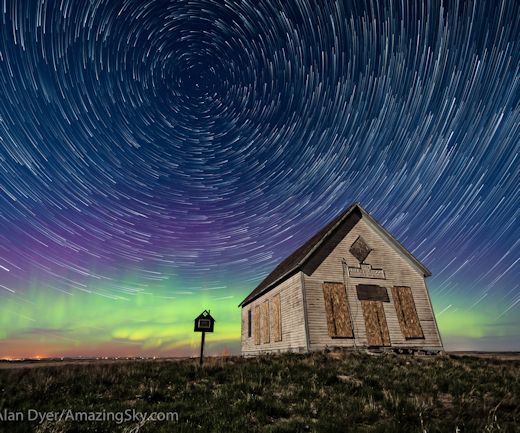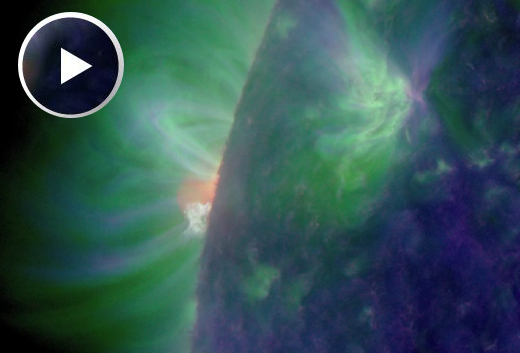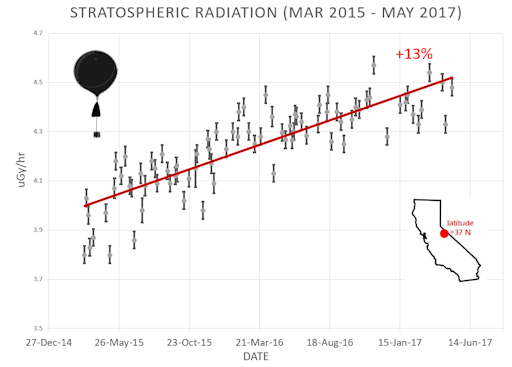 | | | Switch to: Europe, USA, New Zealand, Antarctica Credit: NOAA/Ovation  Planetary K-index Planetary K-index
Now: Kp= 1 quiet
24-hr max: Kp= 3 quiet
explanation | more data
Interplanetary Mag. Field
Btotal: 2.8 nT
Bz: 1.1 nT north
more data: ACE, DSCOVR
Updated: Today at 2349 UT  Coronal Holes: 23 May 18 Coronal Holes: 23 May 18 
Earth is entering a stream of solar wind flowing from the indicated coronal hole. Credit: SDO/AIA  Noctilucent Clouds Our connection with NASA's AIM spacecraft has been restored! New images from AIM show that the southern season for noctilucent clouds (NLCs) is underway. Come back to this spot every day to see AIM's "daily daisy," which reveals the dance of electric-blue NLCs around the Antarctic Circle.. Switch view: Ross Ice Shelf, Antarctic Peninsula, East Antarctica, Polar Updated at: 02-07-2018 17:55:05 Noctilucent Clouds Our connection with NASA's AIM spacecraft has been restored! New images from AIM show that the southern season for noctilucent clouds (NLCs) is underway. Come back to this spot every day to see AIM's "daily daisy," which reveals the dance of electric-blue NLCs around the Antarctic Circle.. Switch view: Ross Ice Shelf, Antarctic Peninsula, East Antarctica, Polar Updated at: 02-07-2018 17:55:05  SPACE WEATHER
NOAA Forecasts | | Updated at: 2018 May 23 2200 UTC FLARE | 0-24 hr | 24-48 hr | CLASS M | 05 % | 05 % | CLASS X | 01 % | 01 % |  Geomagnetic Storms: Geomagnetic Storms:
Probabilities for significant disturbances in Earth's magnetic field are given for three activity levels: active, minor storm, severe storm Updated at: 2018 May 23 2200 UTC Mid-latitudes | 0-24 hr | 24-48 hr | ACTIVE | 30 % | 25 % | MINOR | 10 % | 05 % | SEVERE | 01 % | 01 % | High latitudes | 0-24 hr | 24-48 hr | ACTIVE | 15 % | 15 % | MINOR | 30 % | 30 % | SEVERE | 40 % | 30 % | | | |  | | | | | | | | | | | All-inclusive Northern Lights trips in Tromsø, Norway. Small groups, big experiences! Highly qualified guides ensure unique and unforgettable adventures with a personal touch. Visit Explore the Arctic | | | SOLAR WIND SPARKS AURORAS: NOAA forecasters say there is a 40% chance of minor geomagnetic storms on May 23rd as a stream of solar wind gently Earth's magnetic field. The gaseous material is flowing from a northern hole in the sun's atmosphere. First contact with the stream on May 22nd produced an outbreak of auroral curtains over the Canadian prairies near Majorville, Alberta: 
"We got a decent display despite the glare of the waxing Moon," says photographer Alan Dyer. "I took this picture at the historic pioneer Liberty Schoolhouse, a 1909 vintage one-room school, typical of many built in the prairies more than a century ago. Moonlight provided the illumination." Earth is expected to remain inside this solar wind stream for another 24 hours. More high-latitude auroras could be in the offing, especially in the southern hemisphere where deepening autumn darkness favors their visibility. Free: Aurora Alerts. Realtime Aurora Photo Gallery SOMETHING IN THE OFFING: Just behind the sun's eastern limb, a hidden sunspot is crackling with solar flares. Yesterday, NASA's Solar Dynamics Observatory recorded this movie of hot plasma leaping over the edge of the solar disk: 
In the past day alone, Earth-orbiting satellites have recorded almost a dozen B-class solar flares. Such relatively weak flares would never be mentioned during Solar Max, but any flare is remarkable during the current period of deepening Solar Minimum. In the next day or so, the underlying sunspot will be revealed by solar rotation, and we shall see if it has potential for stronger explosions. Free: Solar Flare Alerts. Realtime Space Weather Photo Gallery A CRYSTAL BALL IN THE STRATOSPHERE: Father's Day is less than a month away. To get ready, the students of Earth to Sky Calculus launched a crystal ball to the stratosphere. Watch the video as the crystal orb travels onboard a giant helium balloon 93,000 feet above Earth's surface, stretching, focusing, and inverting the incredible landscape of the Sierra Nevada mountains behind it: The students are selling these crystal balls as a fundraiser, and you can have one for $229. The 800 gram sphere contains an embedded model of the Solar System, including the sun, eight planets and their moons. It makes an incredible gift for anyone interested in space. Dad-satisfaction guaranteed.
Each crystal ball comes with a unique gift card showing the item at the edge of space and telling the story of its flight. All proceeds support Earth to Sky Calculus and hands-on STEM research. Far Out Gifts: Earth to Sky Store
All proceeds support hands-on STEM education
Realtime Aurora Photo Gallery Every night, a network of NASA all-sky cameras scans the skies above the United States for meteoritic fireballs. Automated software maintained by NASA's Meteoroid Environment Office calculates their orbits, velocity, penetration depth in Earth's atmosphere and many other characteristics. Daily results are presented here on Spaceweather.com. On May. 23, 2018, the network reported 13 fireballs.
(13 sporadics)  In this diagram of the inner solar system, all of the fireball orbits intersect at a single point--Earth. The orbits are color-coded by velocity, from slow (red) to fast (blue). [Larger image] [movies] Potentially Hazardous Asteroids ( PHAs) are space rocks larger than approximately 100m that can come closer to Earth than 0.05 AU. None of the known PHAs is on a collision course with our planet, although astronomers are finding new ones all the time. On May 23, 2018 there were 1907 potentially hazardous asteroids.
 | Recent & Upcoming Earth-asteroid encounters: | Asteroid | Date(UT) | Miss Distance | Velocity (km/s) | Diameter (m) | | 2018 GL1 | 2018-May-18 | 14.3 LD | 5.2 | 69 | | 2018 KN | 2018-May-19 | 11 LD | 7.5 | 27 | | 2018 KD2 | 2018-May-19 | 2.3 LD | 13.3 | 25 | | 2018 JL2 | 2018-May-19 | 10.9 LD | 13.5 | 40 | | 2018 KQ | 2018-May-19 | 8.7 LD | 7.7 | 11 | | 2018 JG1 | 2018-May-20 | 5.3 LD | 8.3 | 45 | | 2018 KK | 2018-May-21 | 12.1 LD | 9.1 | 32 | | 2018 KF1 | 2018-May-21 | 2.2 LD | 8.6 | 26 | | 2018 KS | 2018-May-22 | 2.1 LD | 7.7 | 9 | | 2018 JK | 2018-May-22 | 16.3 LD | 12.5 | 81 | | 2018 KW1 | 2018-May-23 | 0.4 LD | 7.3 | 4 | | 2018 JG2 | 2018-May-25 | 18.4 LD | 6.9 | 61 | | 2018 JK3 | 2018-May-27 | 19.7 LD | 21.8 | 170 | | 2018 KR | 2018-May-28 | 15.7 LD | 4 | 18 | | 68347 | 2018-May-29 | 9.5 LD | 13.3 | 389 | | 2013 LE7 | 2018-May-31 | 17.8 LD | 1.7 | 12 | | 2018 KE1 | 2018-Jun-01 | 10.8 LD | 16.2 | 32 | | 2018 EJ4 | 2018-Jun-10 | 5.6 LD | 6.2 | 195 | | 2015 DP155 | 2018-Jun-11 | 9 LD | 4.4 | 170 | | 2017 YE5 | 2018-Jun-21 | 15.6 LD | 15.5 | 513 | | 467309 | 2018-Jun-23 | 17.9 LD | 14 | 355 | | 441987 | 2018-Jun-24 | 7.3 LD | 12.6 | 178 | Notes: LD means "Lunar Distance." 1 LD = 384,401 km, the distance between Earth and the Moon. 1 LD also equals 0.00256 AU. MAG is the visual magnitude of the asteroid on the date of closest approach. | | Cosmic Rays in the Atmosphere |
Readers, thank you for your patience while we continue to develop this new section of Spaceweather.com. We've been working to streamline our data reduction, allowing us to post results from balloon flights much more rapidly, and we have developed a new data product, shown here: 
This plot displays radiation measurements not only in the stratosphere, but also at aviation altitudes. Dose rates are expessed as multiples of sea level. For instance, we see that boarding a plane that flies at 25,000 feet exposes passengers to dose rates ~10x higher than sea level. At 40,000 feet, the multiplier is closer to 50x. These measurements are made by our usual cosmic ray payload as it passes through aviation altitudes en route to the stratosphere over California. What is this all about? Approximately once a week, Spaceweather.com and the students of Earth to Sky Calculus fly space weather balloons to the stratosphere over California. These balloons are equipped with radiation sensors that detect cosmic rays, a surprisingly "down to Earth" form of space weather. Cosmic rays can seed clouds, trigger lightning, and penetrate commercial airplanes. Furthermore, there are studies ( #1, #2, #3, #4) linking cosmic rays with cardiac arrhythmias and sudden cardiac death in the general population. Our latest measurements show that cosmic rays are intensifying, with an increase of more than 13% since 2015: 
Why are cosmic rays intensifying? The main reason is the sun. Solar storm clouds such as coronal mass ejections (CMEs) sweep aside cosmic rays when they pass by Earth. During Solar Maximum, CMEs are abundant and cosmic rays are held at bay. Now, however, the solar cycle is swinging toward Solar Minimum, allowing cosmic rays to return. Another reason could be the weakening of Earth's magnetic field, which helps protect us from deep-space radiation. The radiation sensors onboard our helium balloons detect X-rays and gamma-rays in the energy range 10 keV to 20 MeV. These energies span the range of medical X-ray machines and airport security scanners. The data points in the graph above correspond to the peak of the Reneger-Pfotzer maximum, which lies about 67,000 feet above central California. When cosmic rays crash into Earth's atmosphere, they produce a spray of secondary particles that is most intense at the entrance to the stratosphere. Physicists Eric Reneger and Georg Pfotzer discovered the maximum using balloons in the 1930s and it is what we are measuring today. | | The official U.S. government space weather bureau | | | The first place to look for information about sundogs, pillars, rainbows and related phenomena. | | | Researchers call it a "Hubble for the sun." SDO is the most advanced solar observatory ever. | | | 3D views of the sun from NASA's Solar and Terrestrial Relations Observatory | | | Realtime and archival images of the Sun from SOHO. | | | from the NOAA Space Environment Center | | | fun to read, but should be taken with a grain of salt! Forecasts looking ahead more than a few days are often wrong. | | | from the NOAA Space Environment Center | | | the underlying science of space weather |  | Reviews here can help you to pick up best memory foam mattresses. | | | These links help Spaceweather.com stay online. Thank you to our supporters! | | | | | | | | |  | |  |   | ©2017 Spaceweather.com. All rights reserved. This site is penned daily by Dr. Tony Phillips. | |

